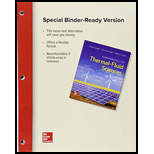
Concept explainers
(a)
The actual coefficient of performance of the refrigerator.
(a)
Explanation of Solution
Given:
The volume flow rate at inlet 1
The heating load rate
The other equipment load rate
Calculation:
Refer Table A-12, “Saturated refrigerant-134a: Pressure table”, obtain the properties of refrigerant R-134a at initial pressure
Refer Table A-13, “Superheated refrigerant-134a”, obtain the properties of refrigerant R-134a at exit pressure
Calculate the mass flow rate of a refrigerant
Calculate the power consumption of the compressor
Calculate the refrigeration load
Write the formula to calculate the actual coefficient of performance.
Thus, the actual coefficient of performance of the refrigerator is
(b)
The maximum coefficient of performance of a reversible refrigerator.
(b)
Explanation of Solution
Write the formula to calculate the maximum coefficient of performance of a reversible refrigerator.
Thus, the maximum coefficient of performance of a reversible refrigerator is
(c)
The minimum volume flow rate at the compressor inlet.
(c)
Explanation of Solution
Calculate the minimum power input to the condenser for the same refrigeration load
Calculate the minimum mass flow rate
Calculate the minimum volume flow rate at the compressor inlet.
Thus, the minimum volume flow rate at the compressor inlet is
Want to see more full solutions like this?
Chapter 7 Solutions
Loose Leaf For Fundamentals Of Thermal-fluid Sciences Format: Looseleaf
 Elements Of ElectromagneticsMechanical EngineeringISBN:9780190698614Author:Sadiku, Matthew N. O.Publisher:Oxford University Press
Elements Of ElectromagneticsMechanical EngineeringISBN:9780190698614Author:Sadiku, Matthew N. O.Publisher:Oxford University Press Mechanics of Materials (10th Edition)Mechanical EngineeringISBN:9780134319650Author:Russell C. HibbelerPublisher:PEARSON
Mechanics of Materials (10th Edition)Mechanical EngineeringISBN:9780134319650Author:Russell C. HibbelerPublisher:PEARSON Thermodynamics: An Engineering ApproachMechanical EngineeringISBN:9781259822674Author:Yunus A. Cengel Dr., Michael A. BolesPublisher:McGraw-Hill Education
Thermodynamics: An Engineering ApproachMechanical EngineeringISBN:9781259822674Author:Yunus A. Cengel Dr., Michael A. BolesPublisher:McGraw-Hill Education Control Systems EngineeringMechanical EngineeringISBN:9781118170519Author:Norman S. NisePublisher:WILEY
Control Systems EngineeringMechanical EngineeringISBN:9781118170519Author:Norman S. NisePublisher:WILEY Mechanics of Materials (MindTap Course List)Mechanical EngineeringISBN:9781337093347Author:Barry J. Goodno, James M. GerePublisher:Cengage Learning
Mechanics of Materials (MindTap Course List)Mechanical EngineeringISBN:9781337093347Author:Barry J. Goodno, James M. GerePublisher:Cengage Learning Engineering Mechanics: StaticsMechanical EngineeringISBN:9781118807330Author:James L. Meriam, L. G. Kraige, J. N. BoltonPublisher:WILEY
Engineering Mechanics: StaticsMechanical EngineeringISBN:9781118807330Author:James L. Meriam, L. G. Kraige, J. N. BoltonPublisher:WILEY





